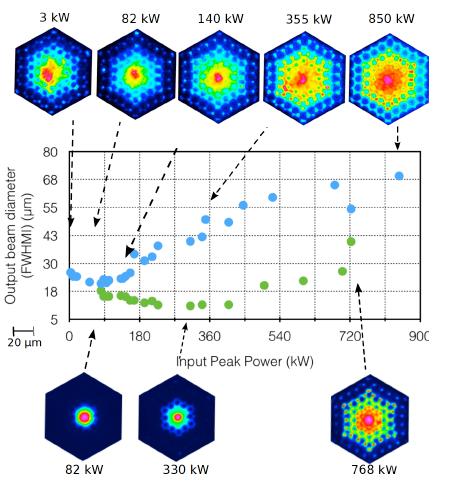Kerr and Raman beam cleanup with supercontinuum generation in multimode microstructure fiber
Stimulated Raman scattering(SRS) in graded index (GRIN) multimode fibers (MMFs) permits to convert a multimode, speckled pump into a high brightness, nearly single mode Stokes beam [1,2]. Recent experiments have revealed that GRIN MMFs may also be used for the delivery of high brightness laser beams, based on the mechanism of Kerr spatial beam self-cleaning [3-5]. For beam powers above the threshold for Kerr beam cleaning, frequency conversion of nearly single mode beams across the entire transparency range of silica glass is achieved by the mechanisms of parametric sideband series and supercontinuum generation [3,4,6,7].
We carried out what is, to our knowledge, the first observation of Raman beam cleanup, Kerr beam self-cleaning, and supercontinuum generation in a microstructure MMF. We used a specially conceived air-silica microstructure MMF, whose transverse structure strongly differs from that of a standard, weakly guiding GRIN MMF. We demonstrate that, unlike beam cleaning in GRIN fibers, the quality of the pump beam at the output of our microstructure fiber does not monotonically increase with growing input power. The Kerr-induced spatial beam cleaning competes with Raman cleanup. Above a certain threshold power, SRS induced Stokes beam cleaning spoils pump self-cleaning, while still enhancing beam brightness on the infrared side of the supercontinuum spectrum.
Fig.1 shows our microstructure MMF, with hexagonal pure silica core surrounded by three layers of air holes as optical cladding, whose diameters gradually increase with the layer order, so that the effective index profile mimicks that of a GRIN MMF.

In our experiments, we used a spatially single-mode laser source at 1064 nm, delivering pulses of 60 ps with the repetition rate of 20 kHz. We first studied the power dependence of the output beam shape at both the pump wavelength and at the first Raman Stokes. Figure 2 summarizes the power evolution of the transverse beam diameter, measured at the output of 11-m long fiber for both the residual pump and the first Raman Stokes beam. At relatively low input pump powers, the output pump exhibits a typical speckled multimodal structure, with a beam diameter close to the size of the inner silica core When increasing the input pump power above 90 kW, Kerr self-cleaning first leads to a narrowing of the output beam diameter, and then its width starts to grow with power, owing to SRS, which introduces a strong energy depletion in the central part of the beam. Whereas, Figure 2 shows that the Stokes beam diameter shrinks down to about 10 microns in diameter, owing to SRS cleanup.

In Fig.3 we show the evolution of modal four-wave mixing, SRS frequency conversion and supercontinuum generation vs. fiber length: beyond 9m, a continuum ranging from 500 nm up to 1800 nm is generated. In the right panel of Fig. 3 we also present a comprehensive overview of the output beam shape from the 9-m long microstructure MMF, at different wavelengths and for increasing peak powers.
In conclusion, we studied nonlinear beam shaping, frequency conversion and supercontinuum generation in a specialty multimode microstructure fiber. We observed Kerr beam self-cleaning, and its competition with Raman beam cleanup. Raman conversion is particularly efficient in the fiber, which results in a progressive transfer of beam brightness towards the infrared side of the spectrum. This effect is accompanied by a loss of beam quality of the residual pump and the first Stokes wave, once it becomes a pump for higher order Stokes beams.

[1] H. Baek, and W. B. Roh, “Single-mode Raman fiber laser based on a multimode fiber”, Opt. Lett. 29, 153 (2004).
[2] N. B. Terry, T. G. Alley, and T. H. Russel, “An explanation of SRS beam cleanup in graded-index fibers and the absence of SRS beam cleanup in step-index fibers”, Opt. Express. 15, 17509 (2007).
[3] K. Krupa, A. Tonello, A. Barthélémy, V. Couderc, B. M. Shalaby, A. Bendahmane, G. Millot, S. Wabnitz, “Observation of geometric parametric instability induced by the periodic spatial self-imaging on multimode waves”, Phys. Rev. Lett. 116, 183901 (2016).
[4] L. G. Wright, Z. Liu, D. A. Nolan, M.-J. Li, D. N. Christodoulides, and F. W. Wise, “Self-organized instability in graded-index multimode fibres”, Nat. Photon. 10, 771 (2016).
[5] K. Krupa, A. Tonello, B. M. Shalaby, M. Fabert, A. Barthélémy, G. Millot, S. Wabnitz, and V. Couderc, “Spatial beam self-cleaning in multimode fibres”, Nat. Photon. 11, 237 (2017).
[6] G. Lopez-Galmiche, Z. Sanjabi Eznaveh, M. A. Eftekhar, J. Antonio Lopez, L. G. Wright, F. Wise, D. Christodoulides, and R. Amezcua Correa, “Visible supercontinuum generation in a graded index multimode fiber pumped at 1064 nm”, Opt. Lett. 41, 2553 (2016).
[7] K. Krupa, C. Louot, V. Couderc, M. Fabert, R. Guenard, B. M. Shalaby, A. Tonello, D. Pagnoux, P. Leproux, A. Bendahmane, R. Dupiol, G. Millot, and S. Wabnitz, “Spatiotemporal characterization of supercontinuum extending from the visible to the mid-infrared in a multimode graded-index optical fiber”, Opt. Lett. 41, 5785 (2016).
